I had the good fortune of being invited to TNVC's first-ever civilian Night Vision training course. What a great experience. I decided to drive from Texas to Georgia, since I was bringing SBR’s, suppressors, and several night vision devices. One of the attendees told a harrowing tale of his guns being lost on a flight from Vermont, so I think I made the right choice. If you are going to travel with SBR's, be sure to get your 5320.20 in at least 30 days prior to departure and pay close attention to airline firearms policies.
In this write-up, I hope to give you an idea as to what you can expect. This course is designed as an advanced rifle and pistol course, with beginner’s introduction to night vision, including the tactical use of image intensification devices, infrared aiming lasers and infrared lights. The course covers basic science, gear management, and shooting technique, including reloading, clearing malfunctions, shooting behind cover and while moving in total darkness. If you go to the Brunswick location, you will be training indoors. You will learn how to use the technique of superimposition with tritium pistol sights and helmet mounted PVS-14 monocular. You will also learn how to use a rifle with IR laser, and then rapidly switch to use of the dot optic on your weapon if / when the lights suddenly come on. I found the list of “things you’ll need,” posted by TNVC, to be just about perfect for preparation.
My personal suggestion would be to look at the list, and then decide how you want to set up your helmet, IR laser, and IR / white light on the rifle. Be sure you are comfortable with placement, and activation whether it be via tailcap clicky or pressure switch. I also recommended that you bring a holster that can accommodate a pistol with light and/or laser mounted.
Before you get to the course location, lay out all your gear and go through your checklist. Keep everything cleared, and practice activating the light, laser and fitting your helmet.
Lay it all out, keep it unloaded, & play with it until you can do it blindfolded.[/span]
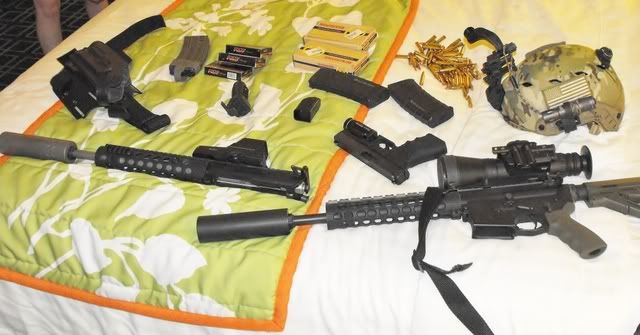
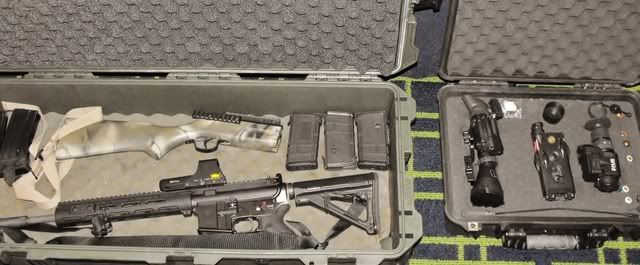
[span style='font-weight: bold;']While shooting the course, I especially liked the Surefire Vampire light, because then you have both white and IR lights on your gun. But beware….the Vampire borders on being too bright for indoor use. You could use an M1IR, but that leaves you without a white light, which you might need if the lights were suddenly turned on (remember that). You can use the M1IR on the helmet, but keep in mind that you might get backsplash off the glass of your optic when the IR light source is behind it. If you are going to learn how to fight with a rifle and pistol, in the dark, then you have to have all contingencies covered.
Power point presentations were given for the various modules and then we went to the range to practice the skill set. They also have an obstacle course which teaches you things like how to maneuver in close quarters, read maps or instructions, and climb ladders using NV. No matter what your use, this course really makes you proficient very quickly….that’s the mark of good teachers.
Classroom
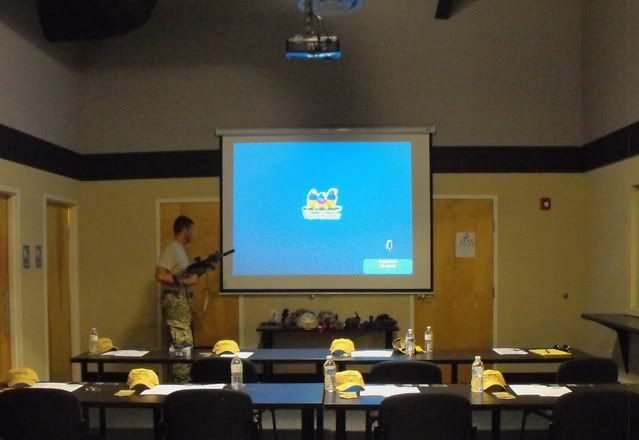
The range and barriers
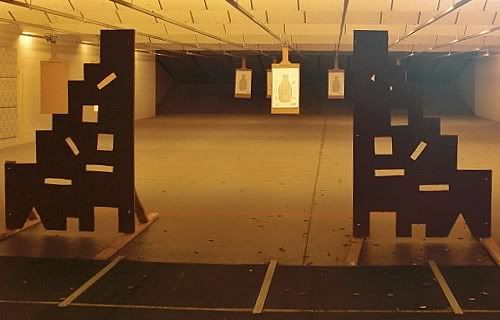
Obstacle course. The ladder is an exercise, not for construction. Note the wood dowels between the walls, on the course entry.
(note: the pic in inverted, not thermal,so as to better show the recesses)...plus it just looked cool)
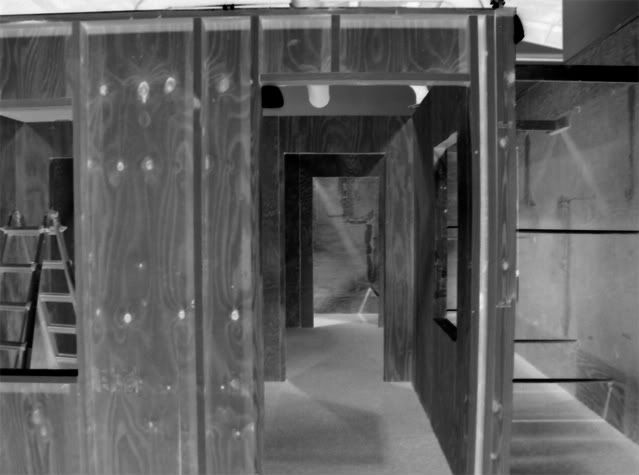
I shot the entire pistol module with a Glock 22, Lone wolf trigger job, Hogue grip and Streamlight TLR 1 light. Holster was a Safariland 6004, which worked perfectly. I shot the rifle module of the class using a 6.8 SPCII. My rifle is a Noveske 12.5” Rogue Lightweight, with Wilson Combat upper, Troy TRX extreme HG, on top of a Spike’s Tactical SBR'ed lower, Wilson Combat TTU-3G trigger, and PRI 6.8 mags. I used a Wilson Whisper suppressor, and it performed perfectly, never coming loose, during or after 400 rounds. I shot SSA factory 6.8 ammo loaded with the 85 grain Barnes frangible “MPG” bullet. The ammo performed flawlessly. I used my own non-autogated, 5 year old PVS-14, 2 battery model (which has presided over hundreds upon hundreds of hogs being sent to hog-hell), and it was mounted to the new Ops-Core Base jump model helmet. I love this helmet, and when paired with Howard Leight e-muffs, the whole rig was totally comfortable. I also used the new eye-safe DBal I^2 IR laser system. It worked perfectly and was easy to zero.
I had only one malfunction, which was caused by an improperly seated mag. I cleared it, but the mag fell out, while I was shooting the barrier drill, and I had to fish around on the floor for the mag, re-insert it and get back in the shoot. I’m sure it didn’t look pretty, but I have done it before, while hunting hogs. My point is that, in the dark, if your mag falls out of the rifle, or you have a serious malfunction, it can disorient you just having to look down. Don’t bother, because you can’t focus on the floor, your hand, or the mag, unless you cap the PVS-14. If you do that, you have either lost muzzle discipline or at least lost the controlling grip on the rifle. Half the battle is knowing that you will have to feel your way through everything. If you have never handled your weapon in the dark, I suggest that you practice it, with the rifle unloaded, before you go to the class. Get to know how the rifle feels in your hands, when it malfunctions, and especially how to “feel” the carrier locking back on an empty mag. You can’t just look at the action when you are wearing a PVS-14, because its too close to focus on the ejection port. Learn how everything feels blind and you will be better prepared.
Shooting the SBR for a little warm-up prior to blackout
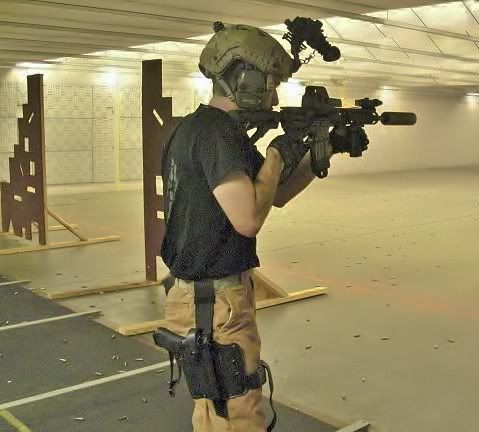
I would also recommend that you prepare to have some good, clean fun. I had a great time, and found the atmosphere to be professional, but very friendly and overall I have to say that this was one of the best experiences I have had in a long time. As with anything else, the more you prepare, the more you will get out of it. Know your gear, and be sure that you are squared-away with safe gun handling. If you don’t have tactical training, then by all means, take the carbine course which is offered as a prerequisite for those of you that don’t have it or aren’t sure of your proficiency level. When you have 12 guys shooting IR laser-equipped SBR’s indoors, in total blackout, with mag dumps and reloads, while moving ….you had better be sharp….but damn is it an adrenaline surge! I never once felt that anyone was unsafe, in our class. The instructors gauged everyone’s skill level and allowed the class to proceed in accordance.
Instruction on the range
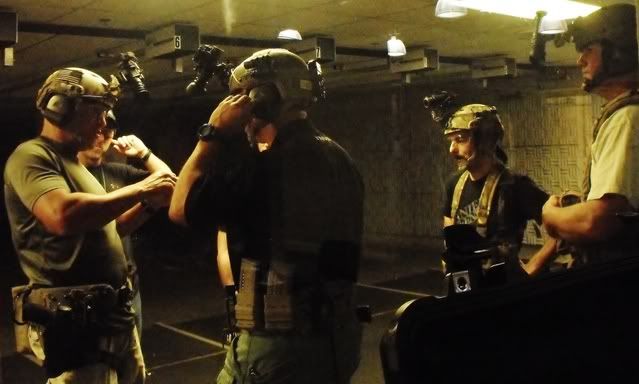
Don & Kyle instructing during pistol module
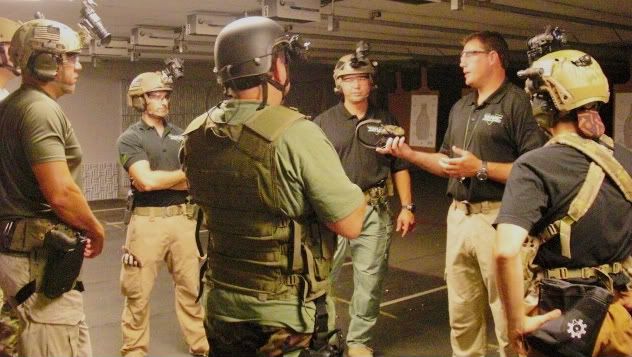
I hope that we can bring this course to Texas, adding instruction on long-distance night time rifle shooting, night hunting techniques using monoculars, dedicated weapon sights and thermal imaging. The course, as it is now, is outstanding.
Enroll now! I think you’ll be glad you did.
In this write-up, I hope to give you an idea as to what you can expect. This course is designed as an advanced rifle and pistol course, with beginner’s introduction to night vision, including the tactical use of image intensification devices, infrared aiming lasers and infrared lights. The course covers basic science, gear management, and shooting technique, including reloading, clearing malfunctions, shooting behind cover and while moving in total darkness. If you go to the Brunswick location, you will be training indoors. You will learn how to use the technique of superimposition with tritium pistol sights and helmet mounted PVS-14 monocular. You will also learn how to use a rifle with IR laser, and then rapidly switch to use of the dot optic on your weapon if / when the lights suddenly come on. I found the list of “things you’ll need,” posted by TNVC, to be just about perfect for preparation.
My personal suggestion would be to look at the list, and then decide how you want to set up your helmet, IR laser, and IR / white light on the rifle. Be sure you are comfortable with placement, and activation whether it be via tailcap clicky or pressure switch. I also recommended that you bring a holster that can accommodate a pistol with light and/or laser mounted.
Before you get to the course location, lay out all your gear and go through your checklist. Keep everything cleared, and practice activating the light, laser and fitting your helmet.
Lay it all out, keep it unloaded, & play with it until you can do it blindfolded.[/span]


[span style='font-weight: bold;']While shooting the course, I especially liked the Surefire Vampire light, because then you have both white and IR lights on your gun. But beware….the Vampire borders on being too bright for indoor use. You could use an M1IR, but that leaves you without a white light, which you might need if the lights were suddenly turned on (remember that). You can use the M1IR on the helmet, but keep in mind that you might get backsplash off the glass of your optic when the IR light source is behind it. If you are going to learn how to fight with a rifle and pistol, in the dark, then you have to have all contingencies covered.
Power point presentations were given for the various modules and then we went to the range to practice the skill set. They also have an obstacle course which teaches you things like how to maneuver in close quarters, read maps or instructions, and climb ladders using NV. No matter what your use, this course really makes you proficient very quickly….that’s the mark of good teachers.
Classroom

The range and barriers

Obstacle course. The ladder is an exercise, not for construction. Note the wood dowels between the walls, on the course entry.
(note: the pic in inverted, not thermal,so as to better show the recesses)...plus it just looked cool)

I shot the entire pistol module with a Glock 22, Lone wolf trigger job, Hogue grip and Streamlight TLR 1 light. Holster was a Safariland 6004, which worked perfectly. I shot the rifle module of the class using a 6.8 SPCII. My rifle is a Noveske 12.5” Rogue Lightweight, with Wilson Combat upper, Troy TRX extreme HG, on top of a Spike’s Tactical SBR'ed lower, Wilson Combat TTU-3G trigger, and PRI 6.8 mags. I used a Wilson Whisper suppressor, and it performed perfectly, never coming loose, during or after 400 rounds. I shot SSA factory 6.8 ammo loaded with the 85 grain Barnes frangible “MPG” bullet. The ammo performed flawlessly. I used my own non-autogated, 5 year old PVS-14, 2 battery model (which has presided over hundreds upon hundreds of hogs being sent to hog-hell), and it was mounted to the new Ops-Core Base jump model helmet. I love this helmet, and when paired with Howard Leight e-muffs, the whole rig was totally comfortable. I also used the new eye-safe DBal I^2 IR laser system. It worked perfectly and was easy to zero.
I had only one malfunction, which was caused by an improperly seated mag. I cleared it, but the mag fell out, while I was shooting the barrier drill, and I had to fish around on the floor for the mag, re-insert it and get back in the shoot. I’m sure it didn’t look pretty, but I have done it before, while hunting hogs. My point is that, in the dark, if your mag falls out of the rifle, or you have a serious malfunction, it can disorient you just having to look down. Don’t bother, because you can’t focus on the floor, your hand, or the mag, unless you cap the PVS-14. If you do that, you have either lost muzzle discipline or at least lost the controlling grip on the rifle. Half the battle is knowing that you will have to feel your way through everything. If you have never handled your weapon in the dark, I suggest that you practice it, with the rifle unloaded, before you go to the class. Get to know how the rifle feels in your hands, when it malfunctions, and especially how to “feel” the carrier locking back on an empty mag. You can’t just look at the action when you are wearing a PVS-14, because its too close to focus on the ejection port. Learn how everything feels blind and you will be better prepared.
Shooting the SBR for a little warm-up prior to blackout

I would also recommend that you prepare to have some good, clean fun. I had a great time, and found the atmosphere to be professional, but very friendly and overall I have to say that this was one of the best experiences I have had in a long time. As with anything else, the more you prepare, the more you will get out of it. Know your gear, and be sure that you are squared-away with safe gun handling. If you don’t have tactical training, then by all means, take the carbine course which is offered as a prerequisite for those of you that don’t have it or aren’t sure of your proficiency level. When you have 12 guys shooting IR laser-equipped SBR’s indoors, in total blackout, with mag dumps and reloads, while moving ….you had better be sharp….but damn is it an adrenaline surge! I never once felt that anyone was unsafe, in our class. The instructors gauged everyone’s skill level and allowed the class to proceed in accordance.
Instruction on the range

Don & Kyle instructing during pistol module

I hope that we can bring this course to Texas, adding instruction on long-distance night time rifle shooting, night hunting techniques using monoculars, dedicated weapon sights and thermal imaging. The course, as it is now, is outstanding.
Enroll now! I think you’ll be glad you did.


